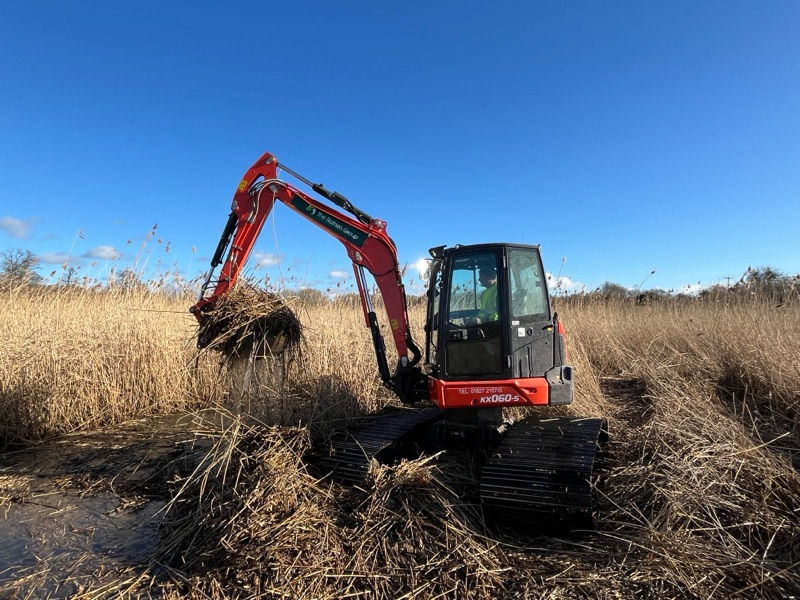
Dredging
Depth where it matters. Dredging keeps canals and rivers flowing – with minimal disruption to nature.
We clear blockages and restore depth where it’s most needed.
Contract services
Our Specialist Dredging Services
The Rothen Group are dredging specialists keeping the UK’s inland waterways clear and moving. From spot dredging around moorings and bridges to full-scale clearances of canals, lakes, and attenuation features, we’ve got the expertise, equipment, and experience to do it right.
Dredging isn’t just about digging – it’s about restoring waterways to their prior condition with the least disruption to local habitats. It’s a necessary part of waterway maintenance. Silt builds up, channels narrow, and water slows. From reactive works to planned maintenance, we come in to fix the problem, using floating dredgers, dredger barges, modular pontoons, and more to reach even the trickiest of spots.
We’re experts in everything from river and canal dredging to pond dredging and more. We also handle disposal and dewatering – turning the silt and spoil into reusable topsoil and compost.
Need reliable dredging for your canal, river, or pond? Speak to The Rothen Group today and see how our dredging specialists can help.

Dredging
View More

Lock
maintenance
View More

Lock
maintenance
View More

Dredging
View More

Dredging
View More

Lock
maintenance
View More

Lock
maintenance
View More

Dredging
View More

Gallery

FEATURED CASE STUDY
Habitat Creation Coney Meadows, Droitwich
Coney Meadows is part of a nationwide project to restore the UK’s wetlands. Since the 17th century, large areas of reedbeds have been stripped and converted into agricultural land, massively reducing the number of habitats available for wetland animals.

FEATURED CASE STUDY
Changing the Shape of the River Derwent, Derby
Following the storm seasons of 2023 & 2024, the EA set out to review its impact on the UK’s waterways. The River Derwent in Derby was flagged after a sonar scan of its navigation identified a scour hole – a direct result of heavy rainfall pushing sediment downstream.
Dredging is the process of removing built-up sediment, silt, and debris from the bottom of a waterway. It’s essential for keeping rivers, canals, lakes and ponds navigable, flood-resistant, and environmentally healthy. Without regular dredging, waterways can become blocked, shallow or polluted, affecting both boat traffic and ecosystems.
The Rothen Group works with Canal River Trust, the Environment Agency, and private waterway owners to dredge some of the UK’s most important canals and rivers. There are three main reasons for dredging:
Navigation. Remove the accumulated silt and debris to ensure the waterway remains deep enough for vessels.
Flood Risk Reduction. River dredging increases the capacity of a river, reducing the risk of localised flooding – especially after heavy rainfall.
Preserving Ecosystems. Dredging maintains the ecological balance of waterways, improving water quality, and helping plants and animals to thrive.
Unfortunately, another common reason is the accumulation of litter and other waste. These materials degrade rivers and canals, making them dangerous to humans and animals.
What is dredging? And why does it matter?
Despite the basic principles of dredging remaining the same, canal and river dredging differ in a few specific ways. These include:
River dredging typically targets deeper, faster-flowing water and often focuses on flood risk reduction and debris removal.
Canal dredging, by contrast, usually involves shallower, slower-moving waters and focuses on maintaining safe navigation for boats, especially around moorings, winding holes and bridges.
How do river and canal dredging differ?
Dredging a river presents numerous challenges. Digging a hole on land might be relatively simple, but removing material from the water is a technical and logistical nightmare.
The Rothen Group relies on our expert dredging specialists, who are experienced in using multiple types of dredging equipment. This includes floating dredgers, modular pontoons, and long-reach excavators. We even have specialist dredging barges that can access the deepest parts of a river. The process is laborious – the material is removed, dried, and then reused as topsoil or compost.
We also manage licensed disposal where reuse isn’t possible, ensuring environmental compliance. Every river dredging project is carefully planned to minimise disruption and maximise efficiency.
How do you dredge a river?
That depends on several factors, including the type of waterway, its usage, and how quickly sediment builds up. Busy canals, moorings, and marinas may require maintenance dredging every 1–3 years, while less active areas might only need it every 5–10 years.
Often, river and canal dredging is ignored for many years until it starts to become an issue. However, an example of proactive dredging is the River Thames, where the Port of London Authority routinely conducts dredging operations to ensure the river is safely navigable.
How often should dredging be carried out?
FAQ
Your questions answered
Our Accreditations
about us
A decade of
The Rothen Group
With decades of experience maintaining the UK’s inland waterways, The Rothen Group is a trusted name in dredging and marine engineering. From targeted spot dredging to large-scale restoration works, we help keep canals, rivers, ponds and lakes clear, navigable and environmentally sound.
Our expert team includes qualified engineers, dredging specialists and plant operators who are passionate about the long-term health of the nation’s water network. By combining proven techniques with modern, specialist equipment, we deliver efficient, low-impact dredging solutions – on time, on budget, and always with care for the ecosystems we work in.














